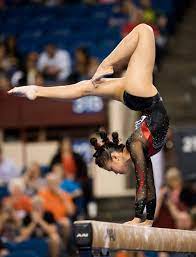From improved strength and coordination to sharper focus and emotional resilience, gymnastics for kids delivers a full-spectrum boost to both body and mind. This dynamic sport lays a foundation for lifelong healthy habits, while also cultivating mental toughness and social confidence from a young age.
In this article, we’ll explore how gymnastics supports children’s physical growth and psychological development—and why it’s quickly becoming one of Australia’s most trusted foundational sports for youth.
How does gymnastics help with physical development in kids?
Gymnastics supports every major component of physical fitness: strength, flexibility, balance, endurance, coordination, and agility.
Children who practise gymnastics regularly show:
- Enhanced core strength and muscle control
- Improved balance and posture, both static and dynamic
- Increased joint flexibility and range of motion
- Faster reaction times and motor coordination
- Greater bone density due to impact-based activities like tumbling
Because gymnastics challenges both fine and gross motor skills, it’s often recommended by paediatric physiotherapists for children who need better body awareness or coordination support.
Why is gymnastics for kids so effective at building strength?
Unlike many sports that focus on isolated muscle groups, gymnastics demands full-body engagement. Whether they’re holding themselves in a plank or swinging from bars, young gymnasts develop powerful stabiliser muscles and learn how to control their own body weight.
Plus, the repetitive nature of skill-building encourages muscle memory and safe strength progression without needing external resistance.
Quick Fact:
A 2022 study published in Frontiers in Sports and Active Living found that preschoolers who participated in gymnastics twice a week for 12 weeks showed significantly higher improvements in strength and dynamic balance than those in general physical education programs.
Read the study
Can gymnastics improve a child’s mental health?
Yes—research consistently shows that gymnastics has mental health benefits, particularly in reducing anxiety, improving focus, and boosting confidence.
Here’s how gymnastics builds mental resilience:
- Goal setting: Children learn to break complex moves into achievable steps, building patience and determination.
- Self-discipline: Classes require active listening, following sequences, and respecting instructions—skills that carry over to school and home life.
- Positive risk-taking: Trying new flips or balances helps children overcome fear and build bravery in a supportive environment.
- Emotional regulation: Learning how to recover from setbacks (like a fall or missed landing) fosters emotional maturity and self-control.
Many parents also report that shy or anxious children become more expressive and outgoing after a term or two of gymnastics.
What age is best to start gymnastics for kids?
Children can begin gymnastics from as young as 18 months with parent-assisted classes. However, ages 3–5 are considered a sweet spot for independent participation and skill building. At this age, kids are developing their sense of body awareness, spatial understanding, and social interaction—all of which are strengthened through structured movement.
Importantly, gymnastics isn’t just for future athletes. It provides a movement foundation that translates beautifully into other sports like dance, diving, athletics, and football.
What life skills does gymnastics teach children?
Gymnastics teaches much more than flips and handstands. It instils lifelong values such as:
- Responsibility: Children learn to show up on time, wear the right gear, and care for equipment.
- Respect: Coaches emphasise respect for teammates, teachers, and one’s own body.
- Growth mindset: Kids quickly see that practice leads to progress—and that failure is part of learning.
These values align closely with Cialdini’s principle of Consistency—as children set and achieve personal goals, they become more motivated to stick with the activity and take pride in their growth.
What social benefits can gymnastics offer?
Beyond physical and mental development, gymnastics is a great way for kids to make friends and feel part of a team—even in an individual sport. Group classes encourage:
- Turn-taking and sharing space
- Encouraging others and celebrating wins together
- Building trust and communication during partner or group routines
Gymnastics centres often run recreational competitions, holiday programs, or performance events that help children showcase their skills, build confidence, and feel recognised for their effort.
Does gymnastics support academic performance?
Yes. The focus and memory skills developed in gymnastics often correlate with better classroom behaviour and academic results.
Children in gymnastics frequently:
- Follow multi-step instructions with greater ease
- Demonstrate improved working memory
- Show higher attention spans and task persistence
That’s because physical activity stimulates the hippocampus—the part of the brain responsible for memory and learning. A regular gymnastics schedule supports both concentration and emotional regulation, helping kids transition more calmly between school, sport, and home.
FAQs
Is gymnastics safe for young kids?
Yes, when taught in a structured environment by qualified coaches, gymnastics is very safe. Centres use foam pits, padded floors, and progressive teaching techniques to reduce injury risk.
How often should kids do gymnastics?
Two sessions per week is ideal for consistent progress, but even once a week provides physical and mental benefits. Rest days are equally important for recovery.
What should kids wear to gymnastics?
Children typically wear a leotard or fitted activewear to allow free movement. Bare feet are preferred for better grip and balance.
Final thoughts
Gymnastics for kids is more than just a sport—it’s a development powerhouse. From stronger muscles and sharper minds to improved emotional resilience and social bonds, gymnastics helps children grow with confidence in every direction.
Whether your child is flipping for fun or building the basics, structured movement can leave a lasting impact. If you’re exploring options for kids gymnastics classes in your area, start by observing a trial class and chatting with coaches about your child’s needs.
For a global perspective on sport and youth development, see this report from the World Health Organization on physical activity and young people.

